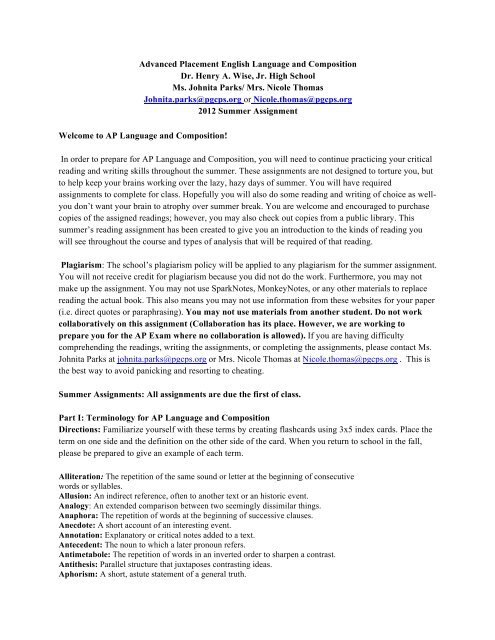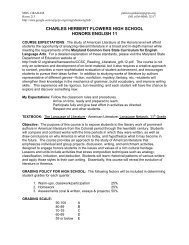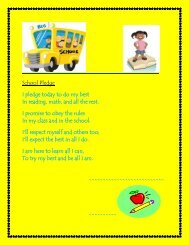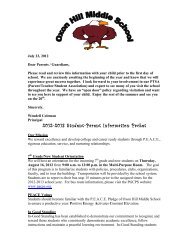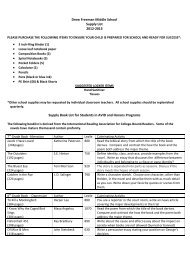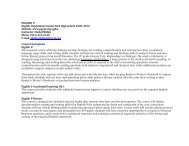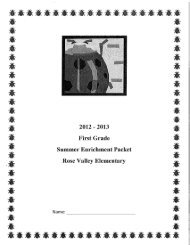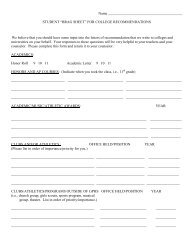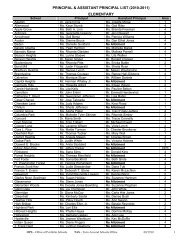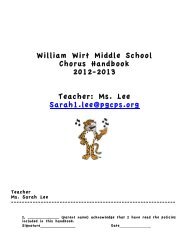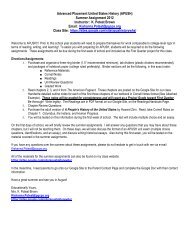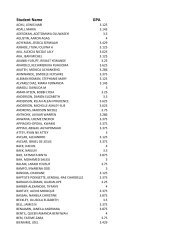AP English Language Summer Assignment
AP English Language Summer Assignment
AP English Language Summer Assignment
- No tags were found...
Create successful ePaper yourself
Turn your PDF publications into a flip-book with our unique Google optimized e-Paper software.
Advanced Placement <strong>English</strong> <strong>Language</strong> and CompositionDr. Henry A. Wise, Jr. High SchoolMs. Johnita Parks/ Mrs. Nicole ThomasJohnita.parks@pgcps.org or Nicole.thomas@pgcps.org2012 <strong>Summer</strong> <strong>Assignment</strong>Welcome to <strong>AP</strong> <strong>Language</strong> and Composition!In order to prepare for <strong>AP</strong> <strong>Language</strong> and Composition, you will need to continue practicing your criticalreading and writing skills throughout the summer. These assignments are not designed to torture you, butto help keep your brains working over the lazy, hazy days of summer. You will have requiredassignments to complete for class. Hopefully you will also do some reading and writing of choice as wellyoudon’t want your brain to atrophy over summer break. You are welcome and encouraged to purchasecopies of the assigned readings; however, you may also check out copies from a public library. Thissummer’s reading assignment has been created to give you an introduction to the kinds of reading youwill see throughout the course and types of analysis that will be required of that reading.Plagiarism: The school’s plagiarism policy will be applied to any plagiarism for the summer assignment.You will not receive credit for plagiarism because you did not do the work. Furthermore, you may notmake up the assignment. You may not use SparkNotes, MonkeyNotes, or any other materials to replacereading the actual book. This also means you may not use information from these websites for your paper(i.e. direct quotes or paraphrasing). You may not use materials from another student. Do not workcollaboratively on this assignment (Collaboration has its place. However, we are working toprepare you for the <strong>AP</strong> Exam where no collaboration is allowed). If you are having difficultycomprehending the readings, writing the assignments, or completing the assignments, please contact Ms.Johnita Parks at johnita.parks@pgcps.org or Mrs. Nicole Thomas at Nicole.thomas@pgcps.org . This isthe best way to avoid panicking and resorting to cheating.<strong>Summer</strong> <strong>Assignment</strong>s: All assignments are due the first of class.Part I: Terminology for <strong>AP</strong> <strong>Language</strong> and CompositionDirections: Familiarize yourself with these terms by creating flashcards using 3x5 index cards. Place theterm on one side and the definition on the other side of the card. When you return to school in the fall,please be prepared to give an example of each term.Alliteration: The repetition of the same sound or letter at the beginning of consecutivewords or syllables.Allusion: An indirect reference, often to another text or an historic event.Analogy: An extended comparison between two seemingly dissimilar things.Anaphora: The repetition of words at the beginning of successive clauses.Anecdote: A short account of an interesting event.Annotation: Explanatory or critical notes added to a text.Antecedent: The noun to which a later pronoun refers.Antimetabole: The repetition of words in an inverted order to sharpen a contrast.Antithesis: Parallel structure that juxtaposes contrasting ideas.Aphorism: A short, astute statement of a general truth.
Appositive: A word or phrase that renames a nearby noun or pronoun.Archaic diction: The use of words common to an earlier time period; antiquatedlanguage.Argument: A statement put forth and supported by evidence.Aristotelian triangle: A diagram that represents a rhetorical situation as therelationship among the speaker, the subject, and the audience (see rhetoricaltriangle).Assertion: An emphatic statement; declaration. An assertion supported by evidencebecomes an argument.Assumption: A belief or statement taken for granted without proof.Asyndeton: Leaving out conjunctions between words, phrases, clauses.Attitude: The speaker’s position on a subject as revealed through his or her tone.Audience: One’s listener or readership; those to whom a speech or piece of writingis addressed.Authority: A reliable, respected source—someone with knowledge.Bias: Prejudice or predisposition toward one side of a subject or issue.Cite: Identifying a part of a piece of writing as being derived from a source.Claim: An assertion, usually supported by evidence.Close reading: A careful reading that is attentive to organization, figurative language,sentence structure, vocabulary, and other literary and structural elementsof a text.Colloquial/ism: An informal or conversational use of language.Common ground: Shared beliefs, values, or positions.Complex sentence: A sentence that includes one independent clause and at leastone dependent clause.Concession: A reluctant acknowledgment or yielding.Connotation: That which is implied by a word, as opposed to the word’s literalmeaning (see denotation).Context: Words, events, or circumstances that help determine meaning.Coordination: Grammatical equivalence between parts of a sentence, oftenthrough a coordinating conjunction such as and, or but.Counterargument: A challenge to a position; an opposing argument.Cumulative sentence An independent clause followed by subordinate clauses orphrases that supply additional detail.Declarative sentence: A sentence that makes a statement.Deduction: Reasoning from general to specific.Denotation: The literal meaning of a word; its dictionary definition.Diction: Word choice.Documentation: Bibliographic information about the sources used in a piece ofwriting.Elegiac: Mournful over what has passed or been lost; often used to describe tone.Epigram: A brief witty statement.Ethos: A Greek term referring to the character of a person; one of Aristotle’sthree rhetorical appeals (see logos and pathos).Figurative language: The use of tropes or figures of speech; going beyond literalmeaning to achieve literary effect.Figure of speech: An expression that strives for literary effect rather than conveyinga literal meaning.Hyperbole: Exaggeration for the purpose of emphasis.Imagery: Vivid use of language that evokes a reader’s senses (sight, smell, taste,touch, hearing).Imperative sentence: A sentence that requests or commands.Induction: Reasoning from specific to general.
Inversion: A sentence in which the verb precedes the subject.Irony: A contradiction between what is said and what is meant; incongruity betweenaction and result.Juxtaposition: Placement of two things side by side for emphasis.Logos: A Greek term that means “word”; an appeal to logic; one of Aristotle’sthree rhetorical appeals (see ethos and pathos) .metaphor: A figure of speech or trope through which one thing is spoken of asthough it were something else, thus making an implicit comparison.Metonymy: Use of an aspect of something to represent the whole.Occasion: An aspect of context; the cause or reason for writing.Oxymoron: A figure of speech that combines two contradictory terms.Paradox: A statement that seems contradictory but is actually true.Parallelism: The repetition of similar grammatical or syntactical patterns.Parody: A piece that imitates and exaggerates the prominent features of another;used for comic effect or ridicule.Pathos: A Greek term that refers to suffering but has come to be associated withbroader appeals to emotion; one of Aristotle’s three rhetorical appeals (seeethos and logos).Persona: The speaker, voice, or character assumed by the author of a piece ofwriting.Personification: Assigning lifelike characteristics to inanimate objects.Polemic: An argument against an idea, usually regarding philosophy, politics, orreligion.Polysyndeton: The deliberate use of a series of conjunctions.Premise: major, minor Two parts of a syllogism. The concluding sentence of asyllogism takes its predicate from the major premise and its subject from theminor premise.Major premise: All mammals are warm-blooded.Minor premise: All horses are mammals.Conclusion: All horses are warm-blooded (see syllogism).Propaganda: A negative term for writing designed to sway opinion rather thanpresent information.Purpose: One’s intention or objective in a speech or piece of writing.Refute: To discredit an argument, particularly a counterargument.Rhetoric: The study of effective, persuasive language use; according to Aristotle,use of the “available means of persuasion.”Rhetorical modes: Patterns of organization developed to achieve a specific purpose;modes include but are not limited to narration, description, comparisonand contrast, cause and effect, definition, exemplification, classification anddivision, process analysis, and argumentation.Rhetorical question: A question asked more to produce an effect than to summonan answer.Rhetorical triangle: A diagram that represents a rhetorical situation as the relationshipamong the speaker, the subject, and the audience (see Aristoteliantriangle).Satire: An ironic, sarcastic, or witty composition that claims to argue for something,but actually argues against it.Scheme: A pattern of words or sentence construction used for rhetorical effect.Sentence patterns: The arrangement of independent and dependent clausesinto known sentence constructions—such as simple, compound, complex, orcompound-complex.Sentence variety: Using a variety of sentence patterns to create a desired effect.Simile: A figure of speech that uses “like” or “as” to compare two things.
Simple sentence: A statement containing a subject and predicate; an independentclause.Source: A book, article, person, or other resource consulted for information.Speaker: A term used for the author, speaker, or the person whose perspective(real or imagined) is being advanced in a speech or piece of writing.Straw man: A logical fallacy that involves the creation of an easily refutable position;misrepresenting, then attacking an opponent’s position.Style: The distinctive qualitiy of speech or writing created by the selection andarrangement of words and figures of speech.Subject: In rhetoric, the topic addressed in a piece of writing.Subordinate clause: Created by a subordinating conjunction, a clause that modifiesan independent clause.Subordination: The dependence of one syntactical element on another in asentence.Syllogism: A form of deductive reasoning in which the conclusion is supportedby a major and minor premise (see premise; major, and minor).Syntax: Sentence structure.Synthesize: Combining or bringing together two or more elements to producesomething more complex.Thesis: The central idea in a work to which all parts of the work refer.Thesis statement: A statement of the central idea in a work, may be explicit orimplicit.Tone: The speaker’s attitude toward the subject or audience.Topic sentence: A sentence, most often appearing at the beginning of a paragraph,that announces the paragraph’s idea and often unites it with the work’sthesis.Trope: Artful diction; the use of language in a nonliteral way; also called a figureof speech.Understatement: Lack of emphasis in a statement or point; restraint in languageoften used for ironic effect.Voice: In grammar, a term for the relationship between a verb and a noun (activeor passive voice). In rhetoric, a distinctive quality in the style and tone ofwriting.Zeugma: A construction in which one word (usually a verb) modifies orgoverns—often in different, sometimes incongruent ways—two or morewords in a sentence.Part II: Readings/ <strong>Assignment</strong>You must read both book titles as outlined below. These selections are included on the approved <strong>AP</strong>Central College Board list for suggested readings. Read with a critical eye and evaluate every argument.Be prepared to dissect the author’s argument with the intent of reconstructing that argument from yourown unique and fresh perspective.Title and SynopsisFast Food NationSchlosser's incisive history of the development of American fast food indicts the industry for someshocking crimes against humanity, including systematically destroying the American diet andlandscape, and undermining values and the economy.Nickel and Dimed: On (Not) Getting by in AmericaEhrenrich wonders if single mothers will be able to survive on their own financially despite recentWelfare reform and the meager earnings they can make at low-wage jobs. To answer this question, shedecides to survive on low wages in three cities in America in this thought provoking investigativereport.AuthorEric SchlosserBarbara Ehrenrich
Complete the following for both books and bring them to class on the first day:Dialectical Journal: You will complete a series of journal entries for each book that demonstratesengagement with the texts, attempts to understand the various arguments presented, and provides asampling of your best critical thinking.For each book, you will complete a chart like the example below. Please be professional—all informationmust be typed (12 point font, Times New Roman print). In addition, you must:• Create a heading with your name, the book title, and book author. You only need one heading foreach book and you must use proper MLA format• Select 5-7 meaningful passages (the sentences can be a sentence or two in a paragraph) thatadequately draw from the beginning, middle, and end of each text.• Write out the entire passage to which you will refer and include the page number from which itcame.• Paraphrase or summarize the passage. It will be helpful to provide the context in which it came.In other words, what is happening before and after this passage appears in the text?• Analyze and react to the passage in full sentences—not notes. Use the Prolific Characteristics toNote sheet for ideas about what you can write about. This should NOT just be a personalreaction or summary; rather, you should attempt to analyze the methods that the writer uses tomake his or her argument. This is where you will show your engagement and reflection. Youranalysis should be longer than the selected quotation or passage.Example set-up:Student Name: John DoeBook Name: The Cheating Culture: Why More Americans are Doing Wrong to Get AheadAuthor: David CallahanQuotation/Passage from the textw/page numberI played a lot of Monopoly growing up. Like mostplayers of the game, I loved drawing a yellowCommunity Chest card and discovering a “bankerror” that allowed me to collect $200. It neveroccurred to me not to take the cash. After all,banks have plenty of money, and if one makes anerror in your favor, why argue? I haven’t playedMonopoly in twenty years, but I’d still take the$200 today. And what if a real bank made an errorin my favor? That would be a tougher dilemma.Such things do happen. (1)Paraphrase or SummaryThe author is remembering that a commonchildhood game had a positive moment when aplayer received “free” cash because a bank made amistake. This is the way the book begins and setsup the idea of the Cheating Culture.Analyze and ReactBy beginning with a reference to a childhoodgame, the author reminds the audience ofsomething that most people probably remember—not just the game, but the excitement of a “bankerror” card. He also issues the question that“banks have plenty of money” so “why argue?”This really mimics what most people wouldprobably say in real life to justify why they shouldkeep money that isn’t rightfully theirs. He movesfrom this game topic to a suggestion that it couldreally happen (which he will explain later) andsuggests that it would be a “tougher dilemma.” Italmost seems like this could be a sarcastic remark.I think many people would just take the money.We tend to view banks as huge institutions thatthey will not miss a few rogue dollars here andthere. This idea that Wall Street continues to payout bonuses while the “little guy” is barely gettingby or may not even have a job is especiallyprevalent now. By this question, the author seemsto be trying to get us to ask if we can even justifythat type of thinking. Is this the right decision tomake?
Prolific Characteristics to Note1. Reader Response: Be able to trace your reactions, to ask questions in class, to remind yourselfwhen you find answers to earlier questions. This should help note the writer’s effectiveness.MAKE NOTE OF:• Your reactions/emotional responses (humor, surprise, sadness, anger, frustration, tension, criticism, confusion, etc.)• Your questions or lack of understanding or doubts (ask “Why?”)• Your revelations (when “things” become clear to you, when you create links between ideas)• Similarities to other works (This reminds me of…)• Wonderful writing—passages that strike you artistically/aesthetically and why2. Speaker: Think about who the writer is and what he or she NEEDS to communicate. This shouldhelp you determine the author’s credibility.MAKE NOTE OF:• Introductory facts (author backgrounds and relationship to the topic, bias, etc.)• Ethos—how does the author establish credibility and character on the given topic?• Note words and language that indicate the author’s attitude or tone and where it shifts• Note when the author directly or indirectly states how he or she feels• Observe key lines that stand out as crucial to the author’s argument3. Occasion: Think about what caused the author to write about this topic and whether or not it is avalid reason.MAKE NOTE OF:• The author’s reasons for writing—what is the motivation?• Historical, political, and social issues surrounding the topic• The author’s personal reasons as well as the greater world influences for the piece• Evidence of views characteristic of the time period and culture surrounding the work• Descriptions of class judgments, racism, gender biases, stereotypes, etc.4. Audience: Think about what kind of person or people the author intended to view the piece. Is theauthor able to connect with that audience effectively.MAKE NOTE OF:• Evidence of who the author is trying to reach• Where the author directly or indirectly addresses a specific audience• Any “call to action” that the author is issuing to the reader• Pathos—does the author appeal to your sense emotion through anecdotes and figurative language5. Purpose: Think about the author’s purpose in writing this book and whether or not he or she iseffective in that purpose.MAKE NOTE OF:• Specific reasons for writing (informing, persuading, arguing, refuting, exemplifying)• Logos—the author’s appeal to reason. Examine how the author makes the reader believe in that purpose.6. Subject: Think about what the book is discussing and whether or not the author shows why thissubject matter is important.MAKE NOTE OF:• Elements related to the problem or issue• How the author develops or deepens the aspects of the problem or issue• How the author shows the complications related to the subject and the implication of it to you, the nation, the world, etc.7. Authorial Devices and Structures in the Argument: Think about the author’s techniques indelivery and how effective the author’s methods are for rhetorical purposes.MAKE NOTE OF:• Changes in point of view/emphasis• Crucial language/vocabulary (not just a word that you don’t understand, but one that seems crucial to understanding theargument)• Stylistic techniques (irony, satire, humor, exaggeration, repetition/patterns, possible symbols, significant metaphors and othernotable literary and rhetorical devices)• How the author’s structure of the argument/book influence the reader and relate to the subject, audience, and purposeALL ASSIGNMENTS ARE DUE THE FIRST DAY OF CLASS. NO EXCEPTIONS!!


